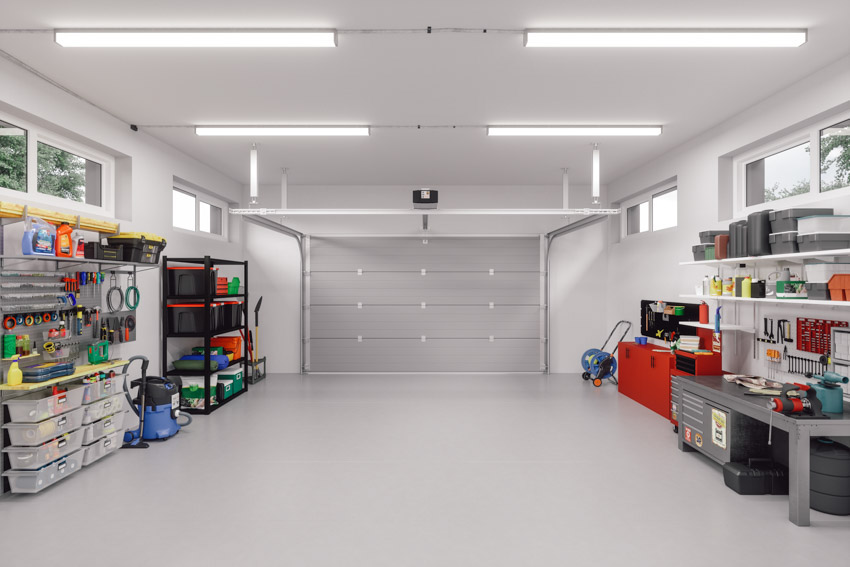Whether you’re a seasoned craftsman or a hobbyist, the right lighting can make a world of difference in your workspace. Here, we explore several effective ways to illuminate your workshop for optimal functionality and comfort.
Natural Light
Harnessing natural light is a game-changer for any workspace, and a workshop is no exception. Positioning your workbench or tools near windows can flood your space with ample daylight.
Not only does natural light reduce eye strain, but it also enhances mood and concentration. Consider installing skylights or larger windows strategically to maximize this free and abundant light source. Don’t forget to opt for blinds or window shades that let light in.
Overhead Lighting
Adequate overhead lighting forms the backbone of any well-lit workshop. Opt for LED tube lights or high-output fluorescent fixtures suspended from the ceiling.
Uniformly spaced overhead lights ensure even illumination across the entire workspace, minimizing shadows and enabling you to work seamlessly from one corner to another.
Task Lighting
Task lighting stands as an indispensable element in any well-equipped workshop. Its role is crucial in providing concentrated illumination to specific areas where detailed and meticulous work takes place.
These focused beams of light not only enhance visibility but also alleviate the strain on your eyes, enabling you to carry out intricate tasks with precision and ease. Whether soldering delicate components or crafting intricate designs, task lighting ensures that every detail is illuminated, allowing for optimal performance in your workshop.
Under-Cabinet Lights
Cabinets and shelves, commonplace in workshops, frequently suffer from inadequate lighting. However, the installation of under-cabinet lighting strips or puck lights is a transformative solution that banishes dark corners and ensures visibility in these less accessible areas.
By eradicating shadows, under-cabinet lights not only improve safety but also streamline the process of locating tools or materials stored within these spaces. The newfound clarity not only minimizes the risk of accidents but also facilitates seamless workflow, enabling you to retrieve items effortlessly and navigate your workshop with confidence and ease.
Portable Work Lights
In larger workshops or when navigating projects beyond the confines of your designated work area, portable work lights become an invaluable ally. Their mobility grants you the freedom to move and precisely direct light to the exact spot where it’s needed most.
These lights eliminate shadows and ensure primal visibility, allowing you to execute tasks with precision and confidence. In essence, portable work lights stand as the embodiment of adaptability, catering to the ever-changing needs of your workshop environment.
Smart Lighting Systems
Integrating smart lighting systems can revolutionize your workshop. With programmable features, these systems allow you to adjust brightness, set timers, and even control lighting remotely via smartphones or voice assistants. Not only do they offer convenience, but they also save energy by optimizing light usage.
Light Diffusers and Filters
Consider using light diffusers or filters to modify the quality of light in your workshop. Diffusers can soften harsh lighting, reducing glare and creating a more comfortable working environment. Filters can alter the color temperature of the light, allowing you to adjust the ambiance to suit different tasks or preferences.
Utilizing both lighting solutions paves the way to the ultimate comfort in your workshop. As most models are portable, their use extends far beyond your work area.
Motion-Activated Lighting
Install motion-activated lights in areas of your workshop that aren’t frequently used or accessed, such as storage closets or less-utilized corners. These lights automatically turn on when motion is detected, ensuring safety and convenience by illuminating these spaces only when necessary.
The ingenious functionality of motion-activated lights doesn’t end there; it champions energy conservation as well. By activating only in response to motion, these lights remain dormant when unoccupied, conserving precious energy resources. This smart approach to lighting not only promotes safety and convenience but also champions sustainability by reducing unnecessary energy consumption.
LED Flood Lights
When looking for a long-term workshop lighting solution, one standout option that warrants attention is the incorporation of LED flood lights. LED flood lights, renowned for their energy efficiency and extended lifespan, emit a broad, high-intensity beam of light.
Their design allows for the effective dispersal of brightness over expansive areas, ensuring a well-lit and productive workspace. Unlike conventional lighting options, durable LED flood lights consume significantly less energy while producing minimal heat, making them a cost-effective and environmentally friendly choice for workshops.
Reflective Surfaces
Utilizing reflective surfaces strategically can amplify the effect of your lighting setup. Painting walls and ceilings with light colors or using reflective materials can bounce light around the workshop, enhancing overall brightness and reducing the need for additional fixtures.
Conclusion
Combining natural light with well-planned artificial lighting sources not only enhances productivity but also creates a conducive environment for honing your craftsmanship. Experiment with these lighting techniques to find the perfect blend that suits your workshop needs, ensuring a well-lit haven for your projects.

